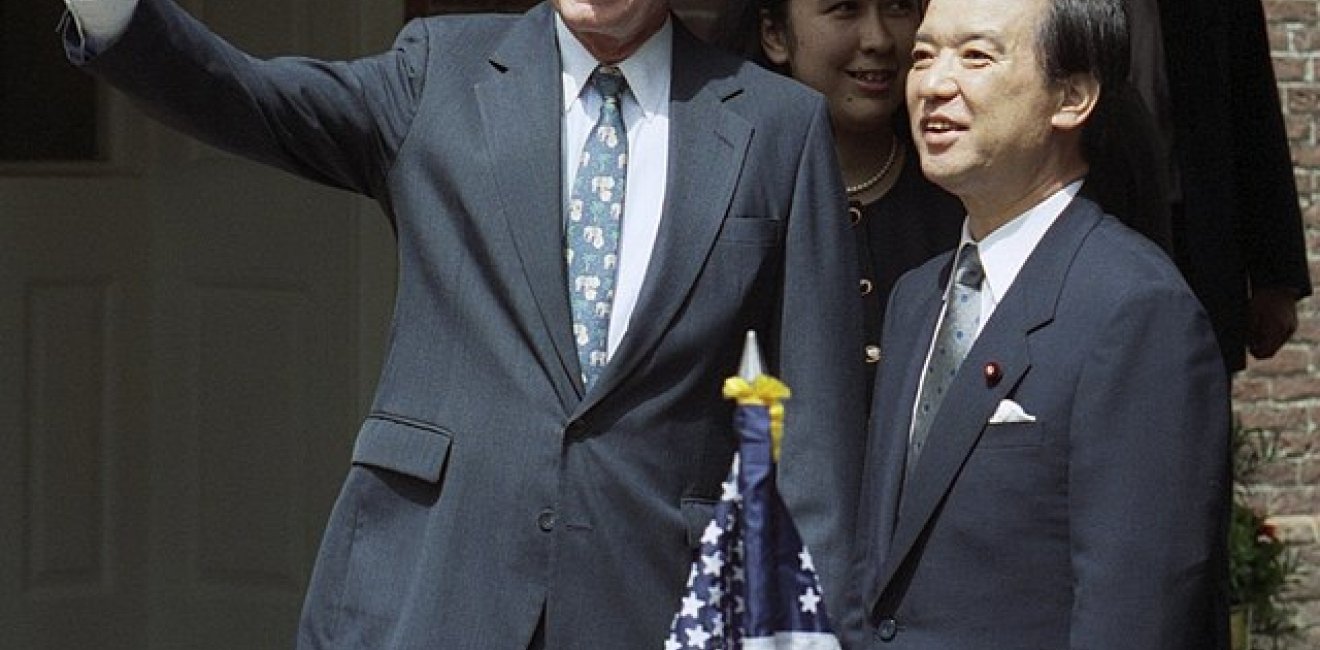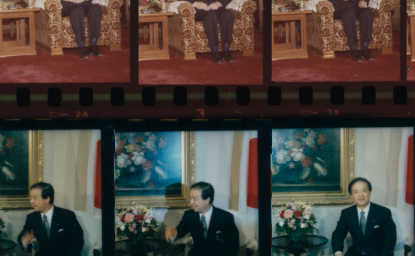The 1990-1991 Gulf War represented an important juncture for Japan’s role in the world, following the end of the Cold War.
During the crisis, Japanese Prime Minister Kaifu Toshiki saw an opportunity to expand Japan’s international influence and visibility on the global stage. Kaifu’s government even contemplated dispatching troops from the Japanese Self-Defense Forces (SDF) to join the multinational force against Iraq. While the Japanese Diet blocked this effort, Kaifu tried to assert Japanese influence in other ways.
Kaifu became personally involved in diplomacy with Iraq and other Middle Eastern states following Saddam Hussein’s invasion of Kuwait. He met with Iraqi First Deputy Minister, Taha Yassin Ramadan, and other heads of state from the region in October 1990, the records of which the Japanese Foreign Ministry recently declassified and published online.
Selected English translations of these meetings, now available through the Wilson Center Digital Archive, provide a rare, fly on the wall perspective of Kaifu’s diplomacy. They also depict in fascinating detail the precarious position that regional leaders in the Middle East found themselves in during the fall of 1990.
Kaifu was originally scheduled to visit the Middle East in August, but postponed his trip following Saddam’s invasion of Kuwait on August 2. In the weeks that followed, Kaifu was under intense pressure from the United States and other friendly nations for Japan to actively participate in the international effort against Saddam Hussein. While Kaifu announced sanctions against Iraq, his hopes to elevate Japanese involvement and influence were stymied in other ways by the Japanese Diet and the Japanese courts.
Kaifu finally managed to reschedule his trip during the first week of October. He visited Egypt, Jordan, Turkey, Saudi Arabia, and Oman in order to meet with heads of state from each country and demonstrate Japan’s steadfast response against Iraq and Japan’s overall engagement with the region. In Jordan, he also sat down briefly with one of Saddam’s top advisors, Taha Yassin Ramadan, where he asked for Iraq to immediately withdraw from Kuwait.
The records of these meetings reveal the complex web of obligations Kaifu tried to navigate as he sought to appease not just the United States and his own people, but each Middle Eastern leader as well – while simultaneously promoting his own agenda. Throughout his tour, heads of state and foreign ministers from the Middle East expressed their deep concern over the impact of sanctions and the threat of a wider war following Saddam’s occupation of Kuwait. For instance, in his conversation with the Crown Prince of Jordan on October 4, the prince highlighted Jordanian fears that military intervention against Iraq would inevitably spiral out of control, leaving his country to suffer the consequences. The Crown Prince explained:
Waging war with Iraq would further militarize the region, including Iran. I cannot even imagine what the scenario would be. In the event that Iraq prepared missiles against Israel, Israel, with satellite intelligence from the United States, would launch a counterstrike. I wonder if this would violate Jordan’s airspace. There is also reporting that the US military would use Jordanian territory. In short, what is clear is that Jordan would be reduced to scorched earth.
Sultan Qaboos of Oman later in the trip outlined Jordan’s difficult political position following the invasion. According to the Sultan, “King Hussein has lost the confidence of his Arab brothers. The reason for this is that he has praised Saddam Hussein for being kind, thoughtful, wise, magnanimous, and for having the Arab cause in his heart. King Hussein probably believes this, but it is a mistaken judgement.” Furthermore, the Jordanian people largely sided with Iraq. “Jordan will survive as a buffer zone between Iraq and Israel,” he elaborated, “so long as it seeks to play that role. If Jordan should stop and side with Iraq, and should Iraq’s influence grow, then domestic extremists will emerge and Jordan’s role will change.”
Other leaders in the region were not so sympathetic to Jordan’s predicament. Egyptian President, Hosni Mubarak, railed against his “former friend,” King Hussein of Jordan, for “whispering to the Jordanian people” that Egypt was responsible for Jordan’s difficult economic and political position. “I am sorry to tell you such things, Prime Minister,” he confided to Kaifu, “but King Hussein is someone who goes around deceiving people.”
Saudi King Fahd, during his October 6 conversation with Kaifu, expressed his own shock at the news of Iraq’s invasion, having been reassured just weeks before, along with Mubarak, that Saddam had no plans to attack Kuwait. “When I heard information from the military in the east, I was unable to believe it right away. Hearing that Kuwait had come under attack I repeatedly asked them: From where had they com under attack? Was it not Iran? Was it really Iraq?”
The records show, with remarkable clarity, the discord among the Arab leaders during the Gulf Crisis. The shock and desperation that some of the regional leaders expressed to Kaifu offer important insights into their mindsets and the chaos Saddam’s attacks unleashed throughout the Middle East.
Kaifu tried to calm his counterparts with promises of economic assistance to lessen the damage of sanctions, but he was not always fully successful. Indeed, the documents make clear that Kaifu felt pressure coming from all sides. With President George HW Bush pressing for Japan to join the military coalition, with the Japanese courts and the opposition challenging his requests to utilize the Japanese Self Defense Forces abroad, and with the local Middle East nations desperate to protect themselves should war break out, the opportunity Kaifu sought to leverage likely felt more like a conundrum.
Connected Documents
Kaifu’s Meetings in Egypt (October 3-4)
Cable No. 1825 from Ambassador Yamada Chusei (Egypt) to the Minister of Foreign Affairs, 'Iraq’s Invasion of Kuwait (Prime Minister Sedky’s Unofficial Comments)', 3 October 1990
Cable No. 1827 from Ambassador Yamada Chusei (Egypt) to the Minister of Foreign Affairs, 'Japan-Egypt Summit (First Meeting: Japan-Egypt Relations)', 3 October 1990
Cable No. 1828 from Ambassador Yamada Chusei (Egypt) to the Minister of Foreign Affairs, 'Japan-Egypt Summit Meeting (First Meeting: The Situation in the Gulf)', 3 October 1990
Cable No. 1862 from Ambassador Yamada Chusei (Egypt) to the Minister of Foreign Affairs, 'The Prime Minister’s Visit to the Middle East (Luncheon with Egyptian President Mubarak)', 8 October 1990
Cable No. 1837 from Ambassador Yamada Chusei (Egypt) to the Minister of Foreign Affairs, 'The Prime Minister’s Visit to Egypt (Conversation in Car)', 4 October 1990
Kaifu’s Meeting with Taha Yassin Ramadan (October 4)
Cable No. 1203 from Ambassador Nonoyama Tadayuki (Jordan) to the Minister of Foreign Affairs, 'Prime Minister Kaifu's Meeting With First Deputy Prime Minister Ramadan (Briefing for Accompanying Reporters)', 4 October 1990
Cable No. 1205 from Ambassador Nonoyama Tadayuki (Jordan) to the Minister of Foreign Affairs, 'Prime Minister Kaifu’s Meeting With First Deputy Prime Minister Ramadan (1 of 2)', 4 October 1990
Cable No. 1206 from Ambassador Nonoyama Tadayuki (Jordan) to the Minister of Foreign Affairs, 'Prime Minister Kaifu’s Meeting With First Deputy Prime Minister Ramadan (2 of 2)', 4 October 1990
Cable No. 2685 from Charge d’Affaires Kunieda Masayuki (Iraq) to the Minister of Foreign Affairs, 'Iraq’s Invasion of Kuwait (Prime Minister Kaifu’s Meeting with First Deputy Prime Minister Ramadan: Press)', 4 October 1990
Taha Yaseen Ramadan Holds Press Conference in Amman, October 4, Refers to Talks with Japanese Prime Minister Toshiki Kaifu, 4 October 1990
Kaifu’s Meetings in Jordan (October 4)
Cable No. 1190 from Ambassador Nonoyama Tadayuki (Jordan) to the Minister of Foreign Affairs, 'Prime Minister Kaifu’s Visit to Jordan (Meeting with the Crown Prince)', 4 October 1990
Cable No. 1191 from Ambassador Nonoyama Tadayuki (Jordan) to the Minister of Foreign Affairs, 'The Prime Minister’s Visit to the Middle East (Meeting with Prime Minister Badran)', 4 October 1990
Cable No. 1197 from Ambassador Nonoyama Tadayuki (Jordan) to the Minister of Foreign Affairs, 'Meeting of Prime Minister Kaifu with Crown Prince Hassan (Briefing for Accompanying Reporters)', 4 October 1990
Cable No. 1202 from Ambassador Nonoyama Tadayuki (Jordan) to the Minister of Foreign Affairs, 'Prime Minister Kaifu’s Visit to Jordan (Tea with the Crown Prince)', 4 October 1990
Cable No. 987 from Ambassador Sengoku Takashi (Turkey) to the Minister of Foreign Affairs, 'The Prime Minister’s Visit to the Middle East (Meeting With King Hussein of Jordan)', 5 October 1990
Kaifu’s Meetings in Turkey (October 5)
Cable No. 994 from Ambassador Sengoku Takashi (Turkey) to the Minister of Foreign Affairs, 'The Prime Minister’s Visit to Turkey (Meeting with Prime Minister Akbulut)', 5 October 1990
Cable No. 998 from Ambassador Sengoku Takashi (Turkey) to the Minister of Foreign Affairs, 'Prime Minister Kaifu’s Visit to the Middle East (Meeting With Prime Minister Akbulut, Press Briefing)', 6 October 1990
Cable No. 451 from Counselor Wanibuchi Kazuo (Saudi Arabia) to the Minister of Foreign Affairs, 'The Prime Minister’s Visit to Turkey (Meeting With President Ozal)', 7 October 1990
Kaifu’s Meetings in Saudi Arabia (October 6-7)
Cable No. 450 from Counselor Wanibuchi Kazuo (Saudi Arabia) to the Minister of Foreign Affairs, 'The Prime Minister’s Visit to the Middle East (Meeting With King Fahd)', 7 October 1990
Cable No. 703 from Ambassador Obara Takeshi (Oman) to the Minister of Foreign Affairs, 'The Prime Minister’s Visit to the Middle East (Talk With Saudi Crown Prince Abdullah)', 9 October 1990
Kaifu’s Meetings in Oman (October 8)
Cable No. 705 from Ambassador Obara Takeshi (Oman) to the Minister of Foreign Affairs, 'The Prime Minister’s Visit to the Middle East (Meeting with Sultan Qaboos)', 9 October 1990
Cable No. 706 from Ambassador Obara Takeshi (Oman) to the Minister of Foreign Affairs, ‘The Prime Minister’s Visit to Oman (Chat With Royal Advisor Al-Zawawi)’, 9 October 1990







